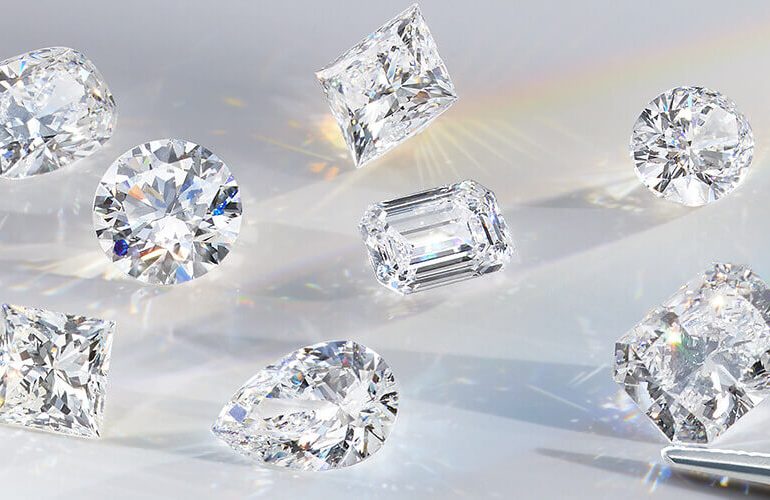Diamonds have long captivated human imagination with their brilliance and enduring allure. Whether you’re considering a dazzling engagement ring or a stunning necklace, understanding the difference between natural diamonds and lab-grown diamonds is crucial in making an informed choice that aligns with your values and preferences.
Table of Contents
Introduction to Diamonds
Diamonds, the hardest natural substance known to man, have been treasured for centuries for their exceptional beauty and durability. They are formed deep within the Earth’s mantle under extreme pressure and heat, emerging as rare and precious gems that symbolize love, commitment, and luxury.
Natural Diamonds: Origins and Characteristics
Formation Process
Natural diamonds are formed over billions of years under high pressure and temperature conditions deep within the Earth’s mantle. Carbon atoms crystalize into the structure we recognize as diamonds and are brought to the surface through volcanic eruptions.
Rarity and Value
Their natural formation makes 천연다이아 랩다이아, contributing to their high value in the market. Factors like color, clarity, cut, and carat weight (known as the 4Cs) determine a natural diamond’s quality and price.
Lab-Grown Diamonds: Modern Innovation
Definition and How They Are Made
Lab-grown diamonds, as the name suggests, are created in controlled laboratory environments using advanced technological processes that simulate the conditions under which natural diamonds form. These processes typically involve high-pressure high-temperature (HPHT) or chemical vapor deposition (CVD) methods.
Differences from Natural Diamonds
While chemically and physically identical to natural diamonds, lab-grown diamonds are distinguishable due to their controlled environment origins. They exhibit the same optical and chemical properties but are grown above ground in weeks rather than millennia.
Comparative Analysis: Natural vs. Lab-Grown Diamonds
Quality Comparison
Both types of diamonds offer excellent quality, with lab-grown diamonds often having fewer inclusions due to their controlled growth environment. Natural diamonds, however, boast unique imperfections that some find more desirable.
Cost Differences
Lab-grown diamonds are typically more affordable than natural diamonds of comparable quality. This price difference reflects their production process and the natural rarity of mined diamonds.
Market Trends
In recent years, the market for lab-grown diamonds has seen significant growth as consumers seek sustainable and ethically sourced alternatives to mined diamonds. This shift is reshaping the diamond industry landscape.
Benefits of Choosing Lab-Grown Diamonds
Affordability
One of the most significant advantages of lab-grown diamonds is their affordability, allowing buyers to purchase larger or higher-quality stones for the same budget as a smaller natural diamond.
Customization Options
Lab-grown diamonds offer greater flexibility in customization, allowing for bespoke jewelry designs that cater to individual tastes and preferences.
Sustainability
Producing diamonds in a lab reduces the environmental impact associated with mining, making lab-grown diamonds a sustainable choice for eco-conscious consumers.
Misconceptions About Lab-Grown Diamonds
Quality Concerns
There is a common misconception that lab-grown diamonds are of lower quality than natural diamonds. In reality, they offer the same brilliance and durability, often with fewer flaws.
Perception in the Jewelry Industry
Traditional views within the jewelry industry sometimes favor natural diamonds, but evolving consumer preferences are driving acceptance and adoption of lab-grown diamonds.
Applications of Diamonds: Natural and Lab-Grown
Natural Diamonds
Natural diamonds find applications in both jewelry and industry, where their hardness and optical properties make them valuable for cutting tools, drills, and even medical equipment.
Lab-Grown Diamonds
Beyond jewelry, lab-grown diamonds are increasingly used in technological applications such as lasers and electronics, showcasing their versatility beyond traditional adornment.
Consumer Awareness and Education
Understanding the Choices
Educating consumers about the differences between natural and lab-grown diamonds empowers them to make informed decisions based on their values, preferences, and budget considerations.
Making an Informed Decision
Whether you choose a natural or lab created diamonds, understanding the nuances of each allows you to select a diamond that aligns with your ethical stance, budget constraints, and personal style.
Environmental Impact: Natural vs. Lab-Grown
Mining Impact
The mining of natural diamonds can have significant environmental consequences, including habitat destruction and water pollution, whereas lab-grown diamonds have a minimal ecological footprint.
Carbon Footprint Comparison
Lab-grown diamonds generally have a lower carbon footprint than mined diamonds, contributing to their appeal among environmentally conscious consumers.
Ethical Considerations
Labor Practices
Concerns about labor practices in diamond mining, including issues related to fair wages and working conditions, have prompted many consumers to seek out ethically sourced diamonds, both natural and lab-grown.
Conflict-Free Sourcing
Both natural and lab-grown diamonds can be sourced ethically, with certifications and transparency playing key roles in ensuring diamonds are conflict-free and responsibly produced.
Future Outlook: Trends in Diamond Industry
Shift Towards Lab-Grown Diamonds
The growing popularity of lab-grown diamonds suggests a significant shift in consumer preferences towards sustainable and ethically sourced alternatives in the diamond industry.
Innovation and Advancements
Ongoing research and technological advancements continue to enhance the quality and production efficiency of lab-grown diamonds, shaping the future of the diamond market.
Conclusion
In conclusion, whether you opt for the timeless elegance of a natural diamond or the innovative sustainability of a lab-grown diamond, both choices offer exquisite beauty and lasting value. Understanding the distinctions between them empowers you to make a decision that aligns with your values and preferences.

